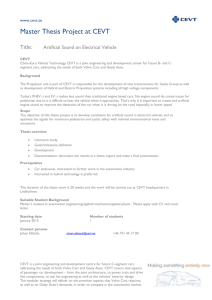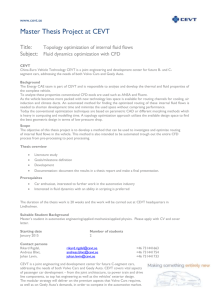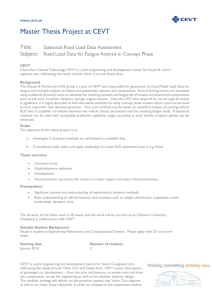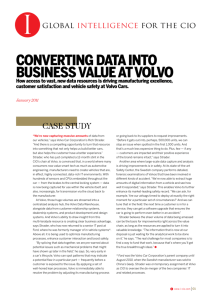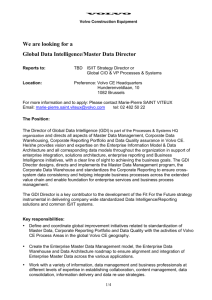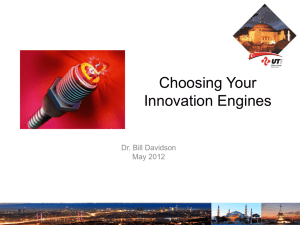The Strategic Acquisition of Volvo Car Corporation
advertisement
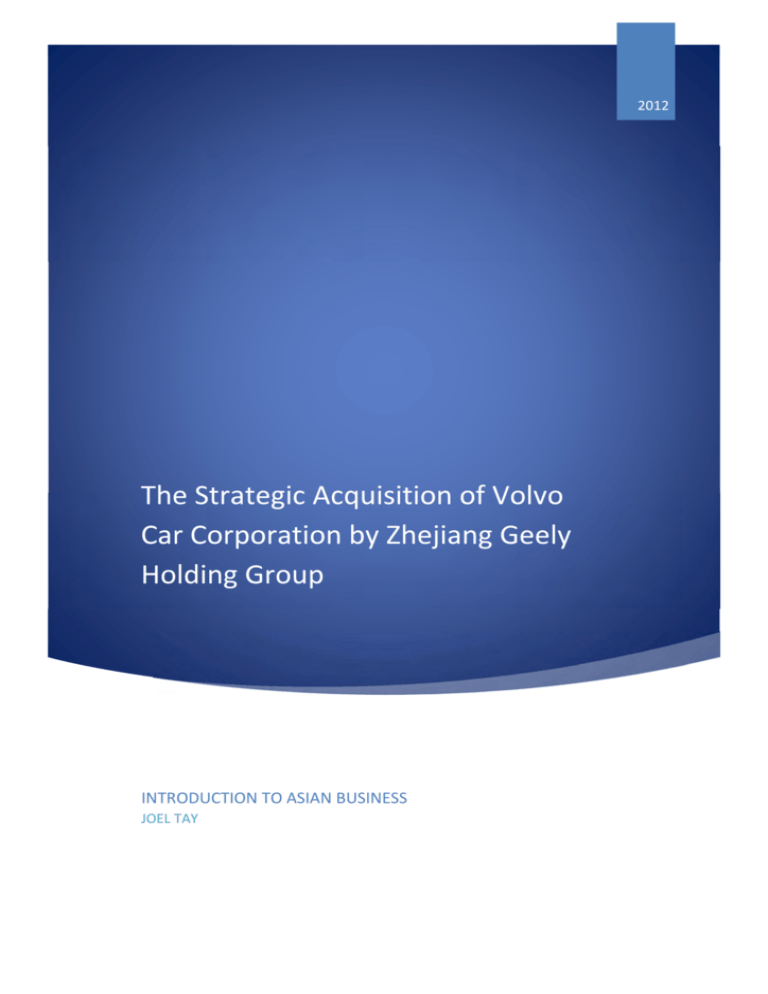
2012 The Strategic Acquisition of Volvo Car Corporation by Zhejiang Geely Holding Group INTRODUCTION TO ASIAN BUSINESS JOEL TAY 1 Contents 1. Abstract ....................................................................................................................................... 2 2. Introduction: The Chinese Automobile Industry and Market..................................................... 2 3. Introduction: Zhejiang Geely Holding Group .............................................................................. 3 4. Introduction: Volvo Car Corporation .......................................................................................... 4 5. Geely’s Ambitions ....................................................................................................................... 5 6. The Obstacles Facing Geely’s Ambitions..................................................................................... 6 7. The Acquisition of Volvo ............................................................................................................. 8 8. Geely’s concenssions to Volvo .................................................................................................. 11 9. Current strategy and sales of Volvo .......................................................................................... 12 10. The challenge of Chinese regulations ................................................................................... 13 11. The implications of full integration ....................................................................................... 14 12. Recommendations ................................................................................................................ 16 13. Conclusion ............................................................................................................................. 17 Works Cited ....................................................................................................................................... 20 2 1. Abstract In this paper, I will analyze and discuss the strategic merits and drawbacks of Chinese automotive manufacturing company Zhejiang Geely Holding Group’s acquisition of the Volvo Car Corporation in 2010. While Geely has only captured a small portion of the Chinese market, it has expanded into other markets across the globe, such as Indonesia, Russia and Chile. While Geely is known as a low-cost mass-market car maker, the acquisition of Volvo will allow them access to Volvo’s vast experience, technological knowhow and distribution channels in the West, allowing Geely to grow and compete better with other automotive firms. At the same time, I will explain how the acquisition has given Volvo a second chance at regaining its profitability should it succeed in the growing automobile market in China. Both firms face great challenges and will have to implement the right strategies to succeed in China and on the global market. Finally, I will give my analysis and recommendations on what both Volvo and Geely should do in order to achieve their strategic objectives. 2. Introduction: The Chinese Automobile Industry and Market The Chinese automobile industry has grown exponentially over the past two decades. From producing less than 2 million vehicles annually in the 1990s, China produced about 9.5 million vehicles in 2008 (Tang 1). This huge increase in terms of production volume has placed China in front of other nations with established automobile industries such as Korea, France, Germany and the United States (Tang 1). One of the key factors of this growth in China lies in the production of passenger cars, which roughly amounts to 65% of all vehicle production (Tang). Looking at the Chinese automobile market, sales alone in the year 2009 from the months January to October topped 10 million vehicles (Tang). In the year 2010, sales figures reached 13 million units, about a 36% increase from the previous year despite the economic downturn (Market Analysis Report 3). With rising disposable incomes and a low per capita private car ownership figure of only 4.78% compared to the average figure of 40% of developed nations as well as an estimated annual growth rate of 13-15% of the auto industry, China is and will continue to be a fast growing market for automobile manufacturers around the world (Market Analysis Report 4). 3 Chinese car sales were increasing year by year (Taken from Wang, Lieke. A Case Study of the Acquisition of Swedish Volvo by Chinese Geely.) 3. Introduction: Zhejiang Geely Holding Group Zhejiang Geely Holding Group is a privately owned Chinese automotive manufacturing company that was founded in 1986. The company is based in the province of Hangzhou in China. Its core competencies lie in the manufacture of automobiles, motorcycles and components such as engines and transmissions. So far, Geely sales have come mostly from the Chinese market, with 75% of its sales of 220,000 cars in 2008 coming from the Chinese mainland and the rest being exported to other countries (“Our Business”). Geely is known to produce cheap bread-and-butter cars that are targeted towards the masses in China. However, with over 52 foreign and domestic automotive brands operating in China, competition has been cutthroat (Hays). With such steep competition, Geely has only managed to capture a small 2.5% of the entire Chinese market (Tang 10). As such, Geely is in need of revamping and differentiating its products from the rest in order to capture greater market share. 4 Competition from foreign and domestic firms is intense in the Chinese market (Taken from Tang, Rachel. The Rise of China’s Auto Industry and Its Impact on the U.S. Motor Vehicle Industry.) 4. Introduction: Volvo Car Corporation Volvo Car Corporation is an established Swedish automotive manufacturing company that was spun off as a subsidiary from AB SKF, a ball-bearing manufacturer, in 1924. The first cars produced by Volvo were strong and steady and were meant to withstand the cold and harsh climate of Sweden. This tradition of producing sturdy and safe cars would later become a symbol of pride as well as one of Volvo’s core competencies (“Our Founders”). In 1999, amidst a consolidation of the auto industry, Volvo was acquired by Ford (Nicholson). The takeover of Volvo was a strategic decision by Ford. Volvo was seen an a luxury European car maker, and the acquisition of it would allow Ford to expand its luxurycar line up, allowing it to have greater access to the luxury car market in Europe. However, since the mid-2000s, Volvo car sales dropped due to increasing competition from other luxury car makers such as Mercedes Benz, Lexus and BMW. Reasons being were changing consumer preferences, unfavorable exchange rates as well as an economic crisis (Krebs). Despite efforts to revive the brand through restructuring and cost cutting measures, Volvo remained unprofitable since 2005. 5 Volvo’s annual sales volume had been dropping since 2005 (with the exception of 2007) (Taken from Wang, Lieke. A Case Study of the Acquisition of Swedish Volvo by Chinese Geely.) Chart shows that Volvo had remained unprofitable since 2005 (Taken from Wang, Lieke. A Case Study of the Acquisition of Swedish Volvo by Chinese Geely.) 5. Geely’s Ambitions Despite only being founded recently in 2001, Geely has been able to command a steady 2.5% market share in China 2008 (Tang 10). However, its main competitors in China are international automotive manufacturers which have partnered with local automotive manufactures. These firms include General Motors and the Shanghai Automotive Industry Corporation (SAIC), Volkswagen and First Automotive Works Corporation (FAW) and 6 Toyota and FAW, of which they own 11.3%, 10.1% and 5.6% respectively (Tang 10). One of the reasons why foreign firms dominate the Chinese market is that they are seen to be “more sophisticated and experienced” than their local counterparts. Facing such competition from foreign and domestic firms, Geely is looking to expand outwards, into the international market to sell its cars. “Geely aims to continue increasing its international presence over the next five years, with a goal to build 15 production bases worldwide and sell two thirds of its cars outside China”, said Mr. Li Shufu who is the chairman and founder of Geely, “[and] to do so the company is growing organically, through its existing car brands, and by considering complementary acquisitions and partnerships” (“Chairman’s Message”). Putting that into figures, according to Liu Jinliang, Geely’s vice president for sales and marketing, is an increase of sales to 2 million cars annually as well as a doubling of market share in China to 5.8% by the year 2015 (“Geely Aims at”) Intent on raising the global profile of Geely, the company participated in the Frankfurt auto show in 2005 and in the following year, was the first ever Chinese automotive manufacturer to participate in the Detroit Auto Show (“What China’s Volvo”). Also, the company announced the development of six modern platforms in 2009, with 42 new models to be launched by the year 2015(“The Ambition of Geely”). In order to support this development drive, the company hired more engineers and had set up a university, the Zhejiang Automotive Engineering Institute, since 2006 to train more engineers (“The Ambition of Geely”). 6. The Obstacles Facing Geely’s Ambitions Although Geely has ambitious plans to expand internationally, they face numerous obstacles along the way. Firstly, being a relatively new company, Geely is not a recognized automotive manufacturer outside of China. While Geely does export its cars out to other countries, the sales volume is low compared to its domestic sales. Also, the majority of countries that they are sold to are developing nations such as Peru, Bangladesh, Uruguay and Pakistan (“Geely Targets To”). As consumers in these developing countries do not have the same purchasing power as their more affluent peers in North America or Europe, their expectations and preferences differ and are more inclined towards the lower end and lower cost cars that Geely 7 manufactures. For comparison, most of Geely’s cars are priced below 100,000 renminbi while a luxury car from Volvo may cost up to over 400,000 renminbi (Wang 14, “Spy Shots”). Due to its perceived inferior image, the Geely brand does not receive much exposure in developed markets such as North America or Europe. Secondly, like most Chinese brands, Geely faces the uphill challenge of meeting safety and emissions regulations established in developed markets. In 2006, the Landwind SUV produced by Chinese automotive company Jiangling Motors Co. Ltd faced scrutiny from various European media when as it was reported to have poor handling and insufficient safety features (Tang 18). In another instance, cars from Chery Automobile Co., another Chinese automotive company, were barred from being sold in the United States of America till they passed safety requirements (Tang 18). Even in less developed markets such as Russia, Geely faced criticism from a Russian car magazine after a crash test, where passengers in a Geely CK saloon were only given a 10% chance of survival (“The Ambition of Geely”). With all these negative publicity against Chinese automobiles, the image of Chinese automotive firms has been affected badly. Thirdly, there is a general stereotype of Chinese cars being blatant copies of foreign cars. As the Chinese did not have a traditional of producing automobiles unlike the Germans or the Japanese, they lacked the expertise to design cars. Therefore, earlier Chinese automobiles that were produced domestically produced cars were reverse-engineered designs of foreign models (Shirouzu). Chinese engineers would examine a foreign car, take out what was perceived as non-critical or expensive items such as airbags and power windows and then put whatever that was left into a “new” car (Shirouzu). However, such actions led to consumers complaining about the lack of creativity, design and reliability about the cars. As a senior engineer at design and engineering firm CH-Auto Technology Corp said, “The problem with those copied cars was that the Chinese were able to emulate the shape of a foreign car, but not its soul” (Shirouzu). Eager to overcome these obstacles, Geely started to look for acquisitions overseas in order to speed up their development processes, and in 2009 bought over Drivetrain Systems International, an Australian firm specializing in automobile transmissions for AUD$52 million (Wang 19). This acquisition allowed Geely to produce cars that had six-speed automatic transmissions. However, this was not enough for Geely, as they wanted to develop at an even quicker pace to fulfill their global ambitions. 8 7. The Acquisition of Volvo Geely’s big break came in December 2008, when Ford announced that they were considering selling Volvo. Despite having had cost-cutting and restructuring measures in place, Volvo had remained unprofitable since 2005. Sales of its cars were falling year by year and with the financial crisis unfolding in 2008, Volvo suffered a $1.5 billion loss (Wang 2324). Not wanting to miss an opportunity to acquire a technological advanced and premium luxury brand, Geely decided to bid for Volvo. In March 2010, the automotive industry was shook up by the acquisition of Volvo by Geely. It was the first time in history that an unknown Chinese automotive firm such as Geely had fully bought over a premium European brand. In August of the same year, Geely completed the acquisition by paying Ford $1.3 billion in cash and $200 million in notes to acquire Volvo, a huge cry from the $6 billion that Ford paid to acquire Volvo in 1999 (Nicholson). For the Chinese, the acquisition was a moment of national pride and a symbol of China’s rising ambition to be a global player in the automobile market but for Geely, the acquisition was a perfect fit for their strategic vision (“What China’s Volvo”). The chart clearly shows the USA and Europe being the main markets for Volvo (Taken from http://www.frost.com/sublib/display-market-insight-top.do?id=198213038) 9 With the acquisition of Volvo, Geely was now closer to achieving its vision of selling two thirds of its cars outside of China as the acquisition had given them a valuable gateway to the lucrative markets of the West such at the United States of America and Europe. With the United States of America already being one of Volvo’s biggest markets, Geely would be able to leverage on established dealerships and distributions networks to sell their cars in America (Kumar). In order to support growth outside of China, Geely had planned to construct more 15 production facilities overseas by 2015 as well, with Mexico designated as “the key for Geely’s ambitions in the Americas” (Kumar). The purchase of Volvo had immediately raised awareness of the Geely brand. Prior to the purchase of Volvo, Geely was not a renowned brand outside of China. On the other hand, Volvo was seen as a prestigious and technologically advanced European brand. Therefore, with Volvo fully under its wings, Geely could leverage on Volvo’s brand equity and hope to imprint unto their own cars the very same positive conceptions that consumers have about Volvo cars, thus improving their own image in the long run. At the same time, expertise and technological know-how from Volvo would grant Geely access to a “perfect platform” to further improve their own product lineup, which could boost the image of its cars in its home market, China (“Geely to Leapfrog”). Another one of the biggest strategic merits of Geely acquiring Volvo is the acquisition of the technology that Volvo has developed over many years. With increasing competition in the Chinese market due to the arrival of foreign competitors, Geely’s chairman Li has placed a huge priority on technological improvements and safety as he sees them as the only way to remain competitive against its rivals (“Volvo Technology”). With Volvo under Geely, technology transfers are possible, allowing Volvo engineers to aid their Chinese counterparts in their engineering capabilities so as to “lay a solid foundation” for Geely to grow further and mature as an automaker (“Volvo Technology”). Being a relatively newcomer to the automobile industry, Geely’s current technology is not as sophisticated as Volvo and as such, Volvo’s know-how in vehicle underpinnings, engines and safety technologies will prove to be valuable to them (Shirouzu). In fact, one of the reasons for the takeover of Volvo was also due to the increased demand for energy efficient cars. According to Li, “new-energy cars represent the future of the international automotive industry”, and as such he has declared that the future cars of Geely would be gas-electric hybrids. Reinforcing the point that Geely needs Volvo’s 10 technologies, Li acknowledged China’s current lack of technology, stating that “China's current research and development investment in this field is far less than that of developed countries" (“Li: Why Does Geely”). With Ford and Volvo having reportedly spent more than 10 years and $10 billion on research and development costs in the technological field of newenergy, the price tag of $1.5 that Geely paid for Volvo seemed to be a great bargain (“Li: Why Does Geely”). Another important aspect of technology that Geely needed from Volvo was related to safety. While Geely’s products had had negative reviews for their crash tests, Volvo had an impeccable safety record for its cars. According to Euro NCAP, an independent assessment authority on evaluating the safety features of a car, every single product of Volvo since 1998 has scored at least 4 or more stars out of five stars with regards to the safety of the car’s adult passengers (Wang 26). On the other hand, a Geely car that was tested by Latin NCAP, which is a close affiliate of Euro NCAP, scored zero stars in a crash test, with it being criticized for having poor protection for most of the driver’s body regions (“Chinese Firm Hits”). As consumers, especially those from Western markets, do consider NCAP ratings when purchasing a car, having negative reviews can affect a brand’s image and sales greatly. Therefore, it was imperative for Geely to improve the safety features of its cars in order to export it to the West. While Volvo was under Ford, they provided with Ford technologic expertise in safety features. One such example would be the shared platforms of the Ford Montero and Focus models and Volvo’s S80/V70 and S40 models which in turn helped Ford attain a better image with regards to safety (Wang 26). Having found themselves in the same situation as Ford in its earlier years, Geely could now try to incorporate Volvo’s safety technologies into their own cars to improve their reputation. Fourthly, with the acquisition, Geely was able to utilize talent from Volvo to improve the designs of their cars. As stated earlier, Chinese carmakers often face criticism over their unflattering car designs, some of which are perceived to be ripped off from foreign car models. One example would be the highly criticized debut of Geely’s GE limousine model at the Shanghai Auto Show in 2009 (“Geely GE Limo”). According to observers, Geely’s model was a rip-off of luxury brand Rolls-Royce prestigious Phantom limousine, with Geely’s GE looking exactly like the Phantom in terms of looks and styling (Chang). In order to break away from the stereotype of being an imitator, Geely brought Peter Horbury, Volvo’s vice president of design into their ranks in 2011. With Mr. Horbury being well known for revolutionizing Volvo’s design concepts by replacing “boxy, utilitarian shapes 11 “ that signified Volvo in the 1970s and 1980s with “sloping, sensuous” stylings, it is anticipated that he will be able to turn design Geely cars into those that appeals to consumers worldwide (Shultz). Geely’s 2009 GE Limousine model (above) was highly criticized as being a copy of Rolls-Royce’s Phantom (below) (Taken from http://www.autocar.co.uk/car-news/motor-shows/geely-its-not-rolls-clone and http://melampah.blogspot.jp/2012/06/rolls-royce-phantom-wallpaper.html) 8. Geely’s concenssions to Volvo Despite being in financial trouble, there was initial resistance inside Volvo to the idea of a buyout from a Chinese firm. Volvo executives and union members were worried and uncomfortable that an acquisition by Geely would lead to a Volvo’s management being replaced and a movement of production facilities and jobs out of Europe, thus destroying the 12 century-old workplace culture and tradition that Volvo had (“Li: Why Does Geely”). Another key issue that Volvo leaders were worried about was that Volvo’s image of a luxury carmaker would be hurt if their cars shared the same technologies and components as those used in cheaper Geely cars (Shirouzu). In response to these concerns, Geely agreed to retain the current management of Volvo and to allow operations to continue independently. Also, current production facilities in Europe would continue to run, labor union agreements would be honored and sales network maintained (“Li: Why does Geely”). In order to quell any worries about the issue of brand dilution, Geely and Volvo have plans to create a new brand of cars containing older Volvo technology that is to be positioned between the lower-cost segment of Geely and the luxury segment of Volvo (Shirouzu). Despite being fully owned by Geely, the Chinese government still views Volvo as a foreign car maker and as such, this arrangement between Geely and Volvo would also fall in line with Chinese regulations which require foreign car makers are to have a 50-50 joint venture with a Chinese car marker in order to manufacture their products in China (Shirouzu). 9. Current strategy and sales of Volvo Although there were many strategic benefits to be gained from acquiring Volvo, there was also a huge cost involved. As stated earlier, Volvo sales in previous years had been falling and losses were piling up. However, Geely’s chairman Li believed that he could turn the company profitable in 2 years from the time of merger. Li believed that the Chinese market would return Volvo to profitability, due to its huge automobile market as well as a premium segment that was estimated to be growing at 100% a year (“Geely’s Volvo Gamble”). One of Li’s first plans was to construct a new manufacturing site in China that would allow Volvo to double its capacity. This increase in production would move in line with Li’s plan to sell 150,000 Volvo cars annually in China by 2012 (Nicholson). In 2011, Volvo announced a $11 billion strategic plan which entails China being a major manufacturing base and market for Volvo with the aim of selling 800,000 cars globally by 2020, which is more than twice than the 373,000 cars Volvo sold in 2010 (“Volvo Technologic Transfer”). According to a report released by Volvo, global sales in 2011 are up 20.43% with 449,225 13 cars sold compared to the previous year. Chinese sales in 2011 have risen up 54.4%, with 47,140 cars sold compared against 2010’s figure of 30,522 cars (Facts and Figures). 10. The challenge of Chinese regulations While Volvo is now treated as a foreign company by Sweden, Volvo is still being classified by the Chinese government as a foreign entity despite being fully owned by Geely. This has proved to be a huge hurdle for executives at Geely, as plans to build factories have been stalled due to delays in receiving approvals from government officials (Liang, Cao). Although the required joint venture between Geely and Volvo is already in the works, this does not work out in favor for Volvo as setting up and running the joint venture would delay the production of Volvo cars in China. One of the biggest issues that Geely chairman Li is disappointed with is the classification of Volvo as a foreign car maker that restricts Volvo cars from being included in the procurement list of government agencies. Due to an initiative by the Chinese government to boost support of home grown automakers, all government agencies have to buy their car fleets from local automakers. As Volvo is not considered a local automaker, this leaves them out of a market that is potentially worth $15 billion (Yan, Ken). On the other hand, MG, a British sports brand which is owned by the Shanghai Automotive Industry Corporation, does not seem to have this problem that Volvo faces. The difference in treatment from the Chinese government could be explained by the fact that MG is fully integrated with SAIC, while Volvo is separate from Geely. Factors that affect how the Chinese government classifies a firm seem to depend on where the firm is incorporated rather than where the majority shareholders are based at (Yan, Ken). As such, in order to be fully considered as a Chinese company, Geely would have to absorb all of Volvo’s assets and close the company that is registered overseas (Yan, Ken). The question is, would Geely be willing to do this? 14 11. The implications of full integration Should Geely choose to fully integrate Volvo, there will be many challenging issues to tackle. Firstly, management practices in Volvo are bound to be different from Geely. Volvo has a long and established working culture and traditions which relatively newcomer Geely does not possess. Volvo has an organized corporate structure with the associated bureaucratic processes that come along it, whereas Geely is led by Chairman Li, who is very much an entrepreneur. Both types of management may come into conflict due to their differences in appetite for risks and attitudes towards hierarchy, decision-making and bureaucracy (Wang 44-45). Another important thing to consider would be the cultural and language differences between Volvo and Geely. While Geely is an Asian firm which uses Mandarin as their working language, Volvo is a Western firm that uses Swedish as their working language. While the Swedish may be able to speak English considerably fluently due to social and economic structure of the European Union, very few Chinese, with the exception of those fortunate enough to be able to study abroad, can speak English fluently (Wang 33). With communication between executives from both sides unable to flow smoothly, a full integration will be a challenging and uneasy task. An important cultural difference between the two is that Chinese people often place more importance on society than the self, while Western people value individualism more (Wang 31). Chinese employees often accept working past their normal office hours while accepting lower remuneration whereas the Swedish are known to abide by their working hours as they treasure their private time more. Also, the Chinese are known to be a highcontext society that abides by hierarchical rules whereas the Swedish are considered to be a low-context society that places an emphasis on democratic values (Wang 31). As such, these differences in culture may prove to be an obstacle among both Volvo and Geely executives when it comes down to managing relationships and decision making. While Volvo’s management has plenty of experience in terms of running a global operation, Geely’s management does not. In terms of size, Volvo is considerably much larger than Geely, with its revenue of $12.4 billion in 2009 being six times larger than that of Geely’s $2.4 billion (“Geely’s Volvo Gamble”). As such, an inexperienced Geely may not have the necessary management skills to fully integrate Volvo. 15 Secondly, there are very few production and marketing-related synergies between Volvo and Geely. While Geely has focused on being a low-cost producer of cars for the masses, Volvo has been focusing on the premium segment (“Geely’s Volvo Gamble”). In terms of marketing strategies, Geely has always been emphasizing its competitiveness in terms of price while Volvo has always been stressed on the safety about its cars. As both automakers have such different platforms and quality standards, it may seem difficult to reduce costs (“Geely’s Volvo Gamble”). Another area that Geely and Volvo might face difficulty is the integration of their information technology and business-to-business infrastructures. With Volvo having much more experience than Geely, it is certain that Volvo’s infrastructure and systems will be more developed than that of Geely’s (Morley). Therefore, integrating the two systems might take a long time and may incur huge costs. Thirdly, brand dilution of Volvo would likely occur should there be full integration between the two brands. Volvo is a highly regarded brand that is recognized worldwide, with a reputation for safety. Being based in Scandinavia gives it an added advantage as consumers perceive the brand to be the culmination of Scandinavian elegance, beauty and ingenuity (Wang 34). On the other hand, Geely’s cars are considerably less renowned than its Swedish counterpart and due to it being based in China, are seen as a low quality product. Should Volvo close its operations in Europe and move to China, it risks losing its value proposition to its customers based in Europe and America. If all production is shifted to China, consumers may associate Volvo with all the negative connotations of products made in China. Also, if Volvo decides to share the same components that are used in Geely’s cars to reduce its costs, the hard earned reputation of the safety of its cars may be lost (Wang 34). According to research, customers of Volvo in China belong to the status-conscious upper class that prefers luxury products from abroad. Therefore, should Volvo move to China, they risk losing and alienating both Western and Chinese consumers (Wang 34). Lastly, a full integration between the two brands would be against the wishes of Geely’s chairman, Li. During negotiations for the merger, Li had already envisioned both firms being separate entities and had planned the direction that both firms were to take. Li had also promised Volvo leaders that the two firms would have operations of one another. A full integration may incur legal complications, damage the credibility of Li and have disruptive impact on current business plans that both Geely and Volvo have. 16 12. Recommendations Although the benefits of full integration would be huge (Volvo would be able to open factories in China quickly, Volvo would be included in the government’s procurement list), the drawbacks of such a move would be even bigger. Of the three main strategic benefits that Geely gained from the acquisition; Distribution channels in the West, Brand Image and Technology, any moves towards full integration would instantly eliminate any gains in distribution channels and brand image. Why? Firstly, consumers in America and Europe would likely not want to purchase a Volvo that has Geely components in it, thus rendering the new distribution channels gained from the acquisition useless. Secondly, while Geely’s image of a low-cost car maker would remain the same, Volvo’s image of a European luxury auto maker would be lost in the case of integration. If these two scenarios occur, the acquisition of Volvo would not make any sense at all as the most important strategic benefits that Geely was seeking out in the first place would not materialize. As such, it is highly recommended for Geely to continue keeping Volvo independent in order to maintain Volvo’s brand equity. Although Geely and Volvo has lost a potentially lucrative deal with Chinese government agencies while at the same time faces delays in opening their factories in China, the long benefits of not integrating seem to be the better choice for both firm in the long run. Geely must understand that a good brand image takes a very long time and hard effort to build and maintain. Even if Geely should want to make any changes in the direction they should take, they should work in hand with the original management at Volvo so as to preserve the brand value that Volvo has. At the same time, Geely can continue to lobby the Chinese government to give full recognition to Volvo as a domestic auto maker. With both Geely and Volvo coming from different countries, there is a cultural and language obstacle to overcome. In order to facilitate smooth communication and understand between both sides, joint cross-border training programs should be implemented by both of them to promote a new working culture consisting of trust, mutual learning and understanding. Geely should hire employees, especially at the managerial level, that are bilingual in both Mandarin and English while Volvo should look to hire people who can speak Mandarin and have had previous experiences in Asia . 17 As the business environment in China is different than that of Western markets, there is a need to identify a clear role and strategy for Volvo in China. Doing business in China would require carefully crafted marketing strategies and sourcing strategies. In order to understand the Chinese market better whilst avoiding the drawbacks of a full integration with Geely, Volvo could create a special task group that oversees operations in China. Whilst the group may contain executives from Geely as the Chinese executives have more experience in China, the group would still report directly to Volvo and not to Geely. With regards to the new brand that Geely and Volvo have to jointly create, executives will have to be exercise great caution and prudence in terms of the customer segmentation, amount of technology shared, pricing and distribution. The new brand will have to identify their customer base and set their pricing correctly so as to not cannibalize any sales from either Geely or Volvo. Also, the jointly-developed brand should not have incorporate too much of Volvo’s features and styling lest it be perceived by consumers as “the poor man’s Volvo”. The new brand’s cars should also be distributed separately; it should not be displayed in the same showroom as a Geely or Volvo car. This would avoid alienating both price-conscious and status-conscious consumers. 13. Conclusion The financial crisis of 2008 signified a shift of economic power from the West to the East. With the shocking acquisition of Volvo, a premium European automotive maker by relatively unknown Chinese automotive company, Geely, China has been put on the world stage as a rising economic powerhouse that is hungry to expand overseas. Despite initial uncertainty, the acquisition of Geely and Volvo seemed to be a mutually advantageous one. Aside the boost to Chinese national pride, the acquisition of a premium European brand would allow Geely access to Western markets, technology and a better brand image; key factors that would enable them have an edge against other domestic competitors as well as to mature as an automaker. On the other hand, Volvo was saved from its financial troubles and would have another chance to regain its profitability should it succeed in the vast and growing Chinese market. However, both Geely and Volvo face many challenges. For Geely and its own cars to succeed on the global stage, they will have to be able to show that their cars are safe to ride 18 in. To do that, Geely has to ensure that its cars fulfill the safety requirements of the various crash tests that are conducted by trusted and recognized independent assessment authorities such as the NCAP. As the new owner of Volvo, Geely has to deal with the different management style and corporate structure of Volvo. As Volvo operations will continue to be run in Europe, Geely has to deal with the cross-continental distance as well. As the two companies are different in nature, with Geely focused on cost while the Volvo on quality, finding synergy between the two brands may prove to be more than difficult. For Volvo, operating in China will be a risky operation. Both Geely and Volvo face discriminatory policies from the Chinese government that are delaying their business plans. Aside from not being able to have Volvo cars included in procurement lists of Chinese government agencies, Geely and Ford are also required to set up a joint venture. The joint venture requires the setting up of a new brand in China, something that would incur extra time, cost and resources. Also, Volvo would be running the risk of diluting its brand image with the joint venture. Although a full integration between Geely and Volvo would solve many of the legal constraints they face in China in the short run, there are no long term benefits. Geely would lose nearly everything that they stood to gain in the merger; namely brand recognition and distribution channels in the west. Also, a full integration would bring about a whole slew of new problems such as cultural and language differences, the brand dilution of Volvo and a potentially lengthy and costly process of integrating systems. Therefore, it would be a better and strategic decision to keep operations of both Volvo and Geely independent of one another. In order to leverage on the growing automotive market of China, both Geely and Volvo have to implement the right strategies in order to succeed. This may be achieved by Volvo setting up a special task group to observe the business environment in China. The group would report directly to Volvo, thus ensuring Volvo’s autonomy. Finally, although both Volvo and Geely come from different business environments and are run by two different kinds of management, they will both have to understand they both of them need each other to survive in the competitive automotive industry. Although the risks of failure are high, the payoff for both Volvo and Geely would be much greater if they succeed. Thus, to achieve that, they will have to work more closely than ever before and be 19 willing to put aside their differences and to learn from one another. Should they succeed, the acquisition will be known as one of China’s biggest and most successful foray overseas. 20 Works Cited "Chairman's Message." Chairman's Message. Geely, n.d. Web. 17 Oct. 2012. <http://www.geely.com/global/about_geely/chairman_message.html>. Chang, Richard S. "A Rolls-Royce Knock-Off From China." Wheels Blog. N.p., n.d. Web. 17 Oct. 2012. <http://wheels.blogs.nytimes.com/2009/04/21/a-rolls-royce-knock-offfrom-china/>. "Chinese Firm Hits New Low in Horror Crash Test." Auto Express. N.p., 25 Oct. 2010. Web. 17 Oct. 2012. <http://www.autoexpress.co.uk/car-news/34328/chinese-firm-hits-newlow-horror-crash-test>. Facts and Figures. Rep. Volvo Car Corporation, n.d. Web. 17 Oct. 2012. <http://www.volvocars.com/intl/top/corporate/volvosustainability/Documents/Facts_and_Figures_2011-12.pdf>. "Geely Aims at 2 Million Sales by 2015." Autoevolution. N.p., n.d. Web. 17 Oct. 2012. <http://www.autoevolution.com/news/geely-aims-at-2-million-sales-by-201527638.html>. "Geely GE Limo - Perfect Rolls-Royce Phantom Clone." Autoevolution. N.p., n.d. Web. 17 Oct. 2012. <http://www.autoevolution.com/news/geely-ge-limo-perfect-rolls-roycephantom-clone-5490.html>. "Geely Targets to Become China's Largest Exporter of Cars." Bloomberg. Bloomberg, 27 Mar. 2012. Web. 17 Oct. 2012. <http://www.bloomberg.com/news/2012-03-26/geelytargets-to-become-china-s-largest-exporter-of-cars.html>. "Geely to Leapfrog into China Luxury Market with Volvo - Channel NewsAsia."Channelnewsasia.com. Mediacorp Pte Ltd., 31 Mar. 2010. Web. 17 Oct. 2012. <http://www.channelnewsasia.com/stories/afp_world_business/view/1047017/1/.html >. "Geely's Volvo Gamble." BloombergBusinessweek. N.p., 15 Apr. 2010. Web. 17 Oct. 2012. <http://www.businessweek.com/managing/content/apr2010/ca20100416_353527.htm >. Hays, Jeffrey. "Facts and Details." CHINESE AUTOMOBILE INDUSTRY AND SALES OF CHINESE CARS ABROAD. N.p., Apr. 2012. Web. 17 Oct. 2012. <http://factsanddetails.com/china.php?itemid=361>. 21 "Li: Why Does Geely Want to Buy Volvo?" People's Daily Online. N.p., 28 Dec. 2009. Web. 17 Oct. 2012. <http://english.peopledaily.com.cn/90001/90778/90860/6854230.html>. Market Analysis Report: China’s Automotive Industry. Rep. N.p.: APCO Worldwide, 2010. Print. Krebs, Michelle. "Volvo Loses $1.5 Billion in 2008; $736 Million Fourth Quarter."AutoObserver. N.p., 29 Jan. 2009. Web. 17 Oct. 2012. <http://www.autoobserver.com/2009/01/volvo-loses-15-billion-in-2008-736-millionfourth-quarter.html>. Kumar, Aswin. "Volvo for Geely A Geely A Global Footprint for China's Henry Ford." Volvo for Global Footprint for China's Henry Ford. Frost & Sullivan, 13 Apr. 2010. Web. 17 Oct. 2012. <http://www.frost.com/sublib/display-market-insighttop.do?id=198213038>. Morley, Mark. "Geely Acquires Volvo Cars, What Will This Mean for the Global Automotive Industry?" All About B2b. N.p., 31 Mar. 2010. Web. 17 Oct. 2012. <http://www.gxsblogs.com/morleym/2010/03/geely-acquires-volvo-cars-what-willthis-mean-for-the-global-automotive-industry.html>. Nicholson, Chris V. "Chinese Carmaker Geely Completes Acquisition of Volvo From Ford."The New York Times. The New York Times, 03 Aug. 2010. Web. 17 Oct. 2012. <http://www.nytimes.com/2010/08/03/business/global/03volvo.html>. "Our Business." Our Business. N.p., n.d. Web. 17 Oct. 2012. <http://www.geely.com/global/our_business/our_business.html>. "Our Founders and Presidents." VOLVO GROUP GLOBAL. VOLVO GROUP GLOBAL, n.d. Web. 17 Oct. 2012. <http://www.volvogroup.com/group/global/engb/volvo%20group/history/volvosfounders/pages/volvo_founders.aspx>. Shirouzu, Norihiko. "Former Volvo Design Chief to Craft New Chinese Brand?" WSJ.com. Dow Jones, 14 Mar. 2012. Web. 17 Oct. 2012. <http://blogs.wsj.com/chinarealtime/2012/03/14/former-volvo-design-chief-to-craftnew-chinese-brand/>. Shirouzu, Norihiko. "Geely Readies Volvo Sharing Deals." The Wall Street Journal. Dow Jones, n.d. Web. 17 Oct. 2012. <http://online.wsj.com/article/SB10001424052970204781804577269134220108246.h tml>. 22 Shirouzu, Norihiko. "Special Report: China's Car Makers Cut Corners to Success." Reuters. Thomson Reuters, 18 Sept. 2012. Web. 17 Oct. 2012. <http://www.reuters.com/article/2012/09/18/us-china-carsidUSBRE88G1DQ20120918>. Shultz, Jonathan. "Peter Horbury, Volvo Design Chief, Is Moving to Geely." Wheels Blog. N.p., n.d. Web. 17 Oct. 2012. <http://wheels.blogs.nytimes.com/2011/11/02/peterhorbury-volvo-design-chief-is-moving-to-geely/>. "Spy Shots: Facelifted Volvo S80L for China." Volvo. N.p., n.d. Web. 18 Oct. 2012. <http://www.carnewschina.com/tag/volvo/>. Tang, Rachel. The Rise of China’s Auto Industry and Its Impact on the U.S. Motor Vehicle Industry. Rep. no. 7-5700. N.p.: Congressional Research Service, 2009. Print. "The Ambition of Geely." The Economist. The Economist Newspaper, 30 July 2009. Web. 17 Oct. 2012. <http://www.economist.com/node/14140382>. "Volvo Technology Transfer a Lifeline for Geely." Reuters. Thomson Reuters, 24 Apr. 2012. Web. 17 Oct. 2012. <http://www.reuters.com/article/2012/04/21/us-volvo-geelytechnology-idUSBRE83K05H20120421>. Wang, Lieke. A Case Study of the Acquisition of Swedish Volvo by Chinese Geely. Thesis. Blekinge Tekniska Högskola, 2011. N.p.: n.p., n.d. Print. "What China's Volvo Deal Means." TIME.com. N.p., 29 Mar. 2010. Web. 17 Oct. 2012. <http://business.time.com/2010/03/29/what-chinas-volvo-deal-means/>. Yan, Fang, and Ken Wills. "Still a China Outsider, Volvo Banks on Linsanity Appeal."Reuters. Thomson Reuters, 21 Mar. 2012. Web. 17 Oct. 2012. <http://www.reuters.com/article/2012/03/21/us-volvo-idUSBRE82K0DT20120321>.
